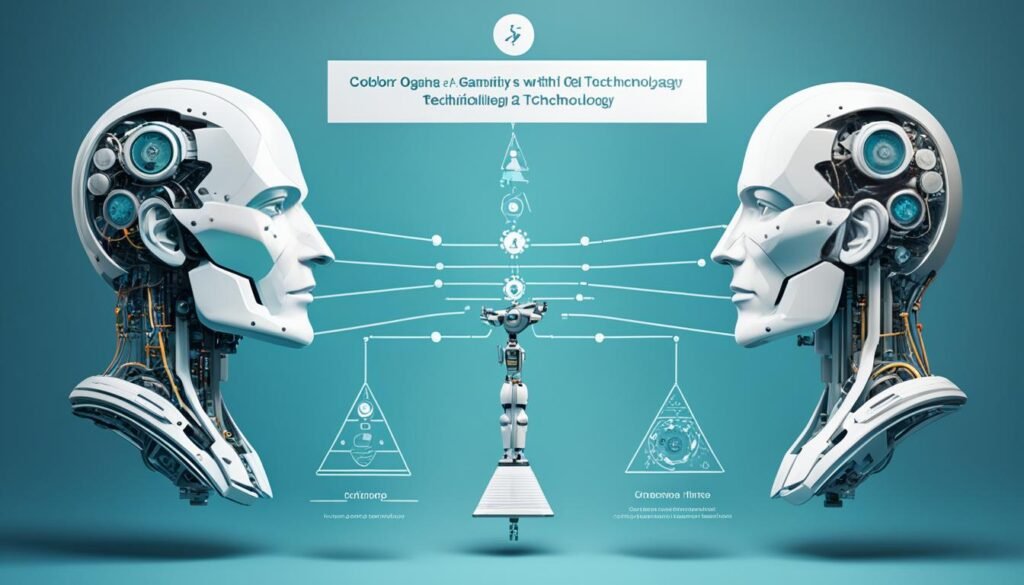Ever curious about the workings of AI and machine learning? How they sift through data, making informed choices? Or the process enabling machines to learn and detect patterns from examples? This article will take you through AI and machine learning’s fascinating realms, revealing the secrets of their astounding capabilities.
AI functions through a phenomenon known as machine learning. Here, computers learn to execute tasks by digesting vast data volumes. This method involves training computers with labeled data sets. Through this, they recognize patterns and make forecasts. Let’s dive into the complexities of AI algorithms and the machine learning process to understand AI’s intellect.
Key Takeaways:
- Machine learning is AI’s core, teaching computers to handle tasks by analyzing data and spotting patterns.
- Machine learning varieties include supervised and unsupervised learning, reinforcement learning, and deep learning.
- For AI systems’ success, data and computing power are pivotal, empowering them to learn and execute complex tasks.
- AI’s future aims at creating artificial general intelligence (AGI) that mimics human cognitive abilities.
- AI learning faces hurdles like securing quality data, tackling bias, ethical issues, and maintaining transparency.
Understanding the Training and Algorithms in AI
Training an AI involves using different algorithms and methods to give the system needed intelligence. Supervised learning is a common technique, where labeled datasets guide the AI. In this process, the AI analyses data and correct answers together. It learns to identify patterns in the data, enabling it to make accurate predictions.
Unsupervised learning, on the other hand, deals with analyzing data without explicit labels. It identifies patterns and structures in vast, unstructured datasets like text or images. This method discovers hidden patterns, offering insights without predefined answers.
Reinforcement learning draws inspiration from how dogs are trained. The AI gets rewards or penalties based on its performance in tasks. This feedback helps it make decisions leading to positive outcomes. Over time, the AI refines its strategies, improving its ability to achieve goals.
Deep learning involves neural networks, modeled after the human brain’s structure, to perform complex tasks. These networks are made of nodes or artificial neurons that process and pass information through layers. This structure lets the network learn intricate representations and hierarchical features.
Deep learning is crucial for AI applications like image and speech recognition, and playing strategic games. Its neural network operations allow AI systems to handle complex tasks, achieving performances similar to humans.
AI Training Methods
Several methods are utilized to boost the performance and adaptability of AI models:
- Batch Learning uses large datasets to train the AI, updating its parameters based on the batch’s overall performance. This method suits large datasets but requires significant computing resources.
- Online Learning trains the AI on individual data samples. It adapts in real-time, ideal for dynamic settings.
- Transfer Learning reuses pre-trained models for similar tasks, cutting down on training time and resources.
- Ensemble Learning combines predictions from several models to enhance accuracy and performance.
These techniques drive the progression of AI technology, letting systems learn and execute complex tasks more efficiently.
The Power of Data and Compute in AI
The success of AI, especially in deep learning, depends on data and computing power. A wealth of varied data lets AI models learn and recognize patterns effectively. By analyzing large datasets, AI algorithms can identify intricate connections and discover insights. This process enables AI systems to forecast outcomes and improve task performance accurately.
Yet, AI’s efficacy isn’t just about data. Processing the massive data collections requires substantial computing power. Complex algorithms are used to refine the AI model’s predictive accuracy and outcomes. Through constant improvement, these algorithms boost the model’s predictive power, allowing AI to adjust to dataset or environmental changes.
“Data is the fuel, and computing power is the engine that propels AI to new frontiers of innovation and efficiency.” – Elon Musk
Recently, we’ve seen leaps in how we collect data and in our processing abilities, driving AI forward. Innovations like cloud computing and parallel processing are broadening AI’s horizons. Thanks to extensive computing resources, AI systems can quickly sift through and analyze data, producing more precise insights.
The synergy of large datasets and vigorous computing resources has been a boon for predictive analytics within AI. This facet of AI uses historical and current data to predict future occurrences, trends, and behaviors. AI algorithms mine vast datasets to discover underlying patterns and connections. This allows companies to make informed decisions, foresee consumer needs, and streamline operations.
Advancements in Data Processing and Algorithm Optimization
| Advancements | Impact |
|---|---|
| Cloud Computing | Provides scalable computing resources and storage for AI data processing. |
| Parallel Processing | Enables simultaneous execution of multiple computing tasks, accelerating data processing and analysis. |
| Optimization Algorithms | Constantly refine AI models, improving their performance and predictive capabilities. |
| Distributed Computing | Allows AI systems to process data across multiple machines, enhancing scalability and speed. |
Recent advances in data handling and algorithm refinement have revolutionized AI. With the fusion of vast data access and advanced computing power, AI is rapidly evolving. It’s surpassing previous limitations, ushering in a new era of machine capability.
The Future of AI
The world of Artificial Intelligence (AI) is rapidly changing, brimming with exciting possibilities. We’re on the brink of achieving artificial general intelligence (AGI). AGI aims for AI that thinks like humans, understanding, learning, and tackling various tasks.
Though AGI remains in the future, AI’s impact is undeniable today. Industries transform and our interactions with technology get revolutionized. Deep learning, natural language processing, and pattern recognition fuel these advancements.
Deep learning, part of machine learning, is critical for AI’s progress. It uses neural networks to sift through massive data, pulling out important insights. This enables AI to recognize patterns, predict accurately, and manage tasks like image recognition and autonomous decisions.
Natural language processing (NLP) is key for AI’s advancement. It allows machines to grasp human language, whether written or spoken. Through language analysis, AI can converse with users, analyze texts, and craft responses that seem human.
Identifying patterns is a core function of AI. Through this, AI can predict, detect anomalies, and uncover insights. This capability lets AI enhance decision-making and optimize operations across fields.
AI’s growth is spurred by a combination of data, algorithms, and computing strength. More data, advanced algorithms, and robust computing are key drivers behind AI’s evolution.
“The future of AI promises groundbreaking innovations across industries, enabling personalized experiences, intelligent systems, and enhanced decision-making capabilities.” – AI expert
The strides in AI bring opportunities and challenges alike. As AI integrates deeper into our lives, ethics, transparency, and fairness are crucial. We must develop and use AI responsibly, ensuring it makes unbiased decisions and respects privacy.
AI’s future is ripe with potential to transform healthcare, transportation, customer experiences, and smart cities. Leveraging deep learning, natural language processing, and pattern recognition, we can tackle complex issues and envision a promising future.
Challenges and Realities of AI Learning
AI learning introduces a spectrum of challenges critical for the responsible growth of AI systems. These include the need for diverse, high-quality datasets and transparency in decision-making. They also involve navigating real-world complexities and addressing bias and fairness. Furthermore, ethical implications demand careful consideration.
Obtaining High-Quality and Diverse Datasets
For AI to learn effectively, diverse and high-quality datasets are vital. They teach AI systems to identify patterns and make accurate predictions. Acquiring these datasets poses a significant hurdle. Ensuring data accuracy, completeness, and representativeness becomes essential. Datasets must also cover a broad array of situations to reflect real-world diversity.
Ensuring Transparency in Decision-Making
Trust in AI systems hinges on transparent decision-making processes. AI’s logic needs to be clear and understandable. Recent efforts focus on explainable AI, revealing the rationale behind AI decisions. This clarity allows users to verify and accept the AI’s decisions, leading to greater accountability and minimizing bias.
Handling Real-World Complexity
The real world’s complexity presents major challenges for AI. AI algorithms must effectively deal with real-life nuances and uncertainties. They need to adapt to unexpected events, ambiguous data, and contextual differences. Crafting AI capable of interpreting and responding to real-world complexity is crucial for their success and relevance.
Addressing Bias and Fairness Concerns
Bias and fairness in AI learning are pivotal issues. Training data biases can lead AI to discriminate, reinforcing existing inequalities. Eliminating bias and ensuring fairness requires diligent data curation and robust algorithm development. Constant monitoring and audits are necessary to identify and correct biases post-deployment.
Considering Ethical Implications
The rise of AI technology brings forth significant ethical questions. As AI integrates more deeply into society, its impact on people, communities, and societal norms cannot be ignored. Ensuring privacy, human rights, and the prevention of harmful biases is crucial. Establishing responsible AI practices prioritizing ethical concerns is fundamental for AI’s future.

Overcoming AI learning challenges demands a holistic, interdisciplinary strategy. It necessitates ongoing research, collaboration across specialties, and stakeholder engagement. By addressing these issues, we can unlock AI’s transformative power responsibly, promoting ethical AI advancements.
Conclusion
AI technology is changing industries with its data processing, algorithms, and machine learning. It analyzes huge data volumes, learning from examples for informed decisions. Machine learning and deep learning let these systems improve and adapt. They manage complex tasks by continuously upgrading their capabilities.
The success of AI is fueled by advancements in data handling and algorithm enhancement. These improvements allow AI models to learn from varied data. With ample computing power, AI can redefine personalized experiences and smart systems. This technology holds promise for a brighter future.
Despite facing hurdles and ethical dilemmas, AI is advancing quickly. It pushes the limits of machine capabilities. As AI’s possibilities unfold, its impact grows, streamlining tasks, solving intricate issues, and evolving our interaction with technology. AI is crafting a future brimming with opportunities.
FAQ
How does AI and machine learning work behind the scenes?
What are the operations involved in neural networks?
How are data processed in AI?
What are the different AI development techniques?
How do AI models learn and improve over time?
What is the role of data and computing power in AI?
How does deep learning contribute to AI?
What is the future of AI?
What challenges does AI learning face?
How does AI technology impact our world?
Source Links
- https://medium.com/@jamesajjen/unveiling-the-mechanics-of-ai-how-artificial-intelligence-works-d0b10bbe783d
- https://englishpluspodcast.com/the-mind-of-the-machine-unveiling-the-secrets-of-ai-learning/
- https://www.linkedin.com/pulse/unveiling-magic-how-machine-learning-transforms-vidhya-radhakrishnan




